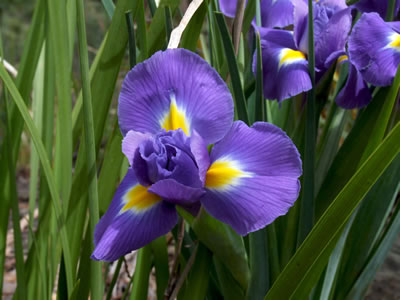DIVIDING PERENNIALS
Perennial plants will always be popular in the garden because they require so little care. Sooner or later, however, many perennials will get “too big for their britches” and will need to be divided.
How will you know when a perennial plant needs to be divided?
Some may need to be divided every 3-4 years, others will quite happily grow for up to ten years before they need to be divided, and a few species don’t like to be divided at all. The best thing to do is to let the plants tell you when it’s time.
Divide a perennial when you notice any of the following symptoms:
1. The plant is flowering less than usual and the blooms are smaller
2. Growth in the center of the plant is dying, leaving a hole in the center with growth only around the edges
3. The plant isn’t growing as vigorously as it has in the past
4 The plant has outgrown its space and is becoming crowded by its neighbors
Spring is the best time to divide most perennials, although there are some exceptions to the rule.
Perennials that bloom in the spring, such as iris and poppies, can be divided in late summer to early fall.
Some plants don’t like to be divided or moved at all. These homebodies include peonies and tree peonies, foxtail lilies, bleeding hearts, goatsbeard and butterfly milkweed. They should be divided only when absolutely necessary.
Never divide a perennial while it is blooming as this would be too stressful for the plant.
The first time you divide a perennial, you’re going to be nervous about it. That’s natural, this process makes every gardener nervous at first. But the more you divide perennials, the easier
it will become. Dividing perennials is often more stressful for the gardener than for the plants.
Follow these simple steps to divide your perennials:
1. Start by digging around the perimeter of the plant with a sharp spade
2. After digging all around the plant, slide your spade beneath the clump and lift it out of the ground
3. Use a sharp spade or a knife to cut the clump into smaller, more manageable plants
4. Discard any sections of the plant that are dead and trim off any damaged roots
5. Keep the divisions moist and in the shade until they can be replanted
6. Replant the divisions at the same depth the plant was originally growing
7. Water the newly planted divisions well and keep them from drying out while they re-establish themselves
Have a great week!
-Mike McGroarty

Hi my daughter wanted a flower bed in front of here house. I divided the the plants I have growing and potted them up until she was ready to plant her garden. Thanks Mike for all the info it’s great.
I bought an old house recently, and with it- pretty messy front and back yards. The back yard is a blank canvas, there’s a very ugly straight concrete walk that dissects the yard in two halves, and just grass and weeds everywhere. I’m having fun planning beds and other things for it.
Then I have the front yard. The previous owner planted a lot of things in the two beds against the house. Key words- a lot. I tried to count how many daililies are there, and it’s such a mess I couldn’t. There’s hostas under the mess too. And tulips. Even irises. And only God knows what else (I found what looks like old hollyhocks sticks).That I discovered because I was trying to count how many plants I had. I don’t think they have been touched in 30-40 years.
That said, my question is- do I need to wait until the fall to divide, remove and redo these beds? I was going to do it, but a neighbor said I have to wait. They are not even flowering, there’s so many! There’s also no plan or concert to the whole thing, and it makes the house look awful. I was thinking of adding two more beds and use some of the extra plants for them.
Also, there’s a line of peony plants (8 of them) that look like they were stepped on by a giant. I tried staking them, and they still look bad. Is there a way of preventing them from going floppy like that?
Thanks! I love this blog 🙂
Julia,
Hostas and daylillies for sure can be divided now. The other perennials? If you keep them watered well they should be okay but really? What do you have to lose. You can’t wait forever to get this job done.
Some perennials can look like 30-40 years of neglect within 4 years if crowded and need dividing…I know this first hand! You probably have enough to fill that back yard.